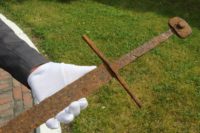 An intact late medieval longsword has been found in a peat bog in Poland. It was discovered in late May by excavator operator Wojciech Kot during drainage operations at the bog in the municipality of Mircze, 12 miles south of the town of Hrubieszów in southeastern Poland. The next day, Kot contacted the Fr. Stanisław Staszic Museum in Hrubieszów and the day after that he brought the sword to the museum in person. Then he took the museum experts to the peat bog where he showed them the exact find spot which is not being revealed to keep treasure hunters from despoiling it.
An intact late medieval longsword has been found in a peat bog in Poland. It was discovered in late May by excavator operator Wojciech Kot during drainage operations at the bog in the municipality of Mircze, 12 miles south of the town of Hrubieszów in southeastern Poland. The next day, Kot contacted the Fr. Stanisław Staszic Museum in Hrubieszów and the day after that he brought the sword to the museum in person. Then he took the museum experts to the peat bog where he showed them the exact find spot which is not being revealed to keep treasure hunters from despoiling it.
 The cruciform-handled sword is corroded from centuries spent in a wetland and is missing the original hilt which would have been made out of wood, bone or antler, but it is otherwise intact from pommel to tip. Its original weight is estimated to have been just 1.5 kilos (3.3 lbs) which is light as a feather for a weapon that today is 120 centimeters (four feet) long. The elongated grip was intended for two-handed use which coupled with its long reach and light weight made the sword an agile weapon for armoured knights in battle. This design is typical of the 14th century.
The cruciform-handled sword is corroded from centuries spent in a wetland and is missing the original hilt which would have been made out of wood, bone or antler, but it is otherwise intact from pommel to tip. Its original weight is estimated to have been just 1.5 kilos (3.3 lbs) which is light as a feather for a weapon that today is 120 centimeters (four feet) long. The elongated grip was intended for two-handed use which coupled with its long reach and light weight made the sword an agile weapon for armoured knights in battle. This design is typical of the 14th century.
On the back of sword is a symbol, an isosceles cross inside an heraldic shield, that Bartecki thinks is a maker’s mark engraved by the blacksmith. This was a very fine piece of craftsmanship. It is still well-balanced, in excellent condition and does not show any signs of having been deliberately discarded due to damage.
“The place where the discovery was made is a wetland and a peat bog. It is possible that an unlucky knight was pulled into the marsh, or simply lost his sword” – told PAP Bartłomiej Bartecki, director of Fr. Stanisław Staszic Museum in Hrubieszów. […]
The area is first appears on the historical record in the 13th century where it’s mentioned as the site of a few hunting lodges surrounded by forest. The region was part of Ruthenia (aka the Kievan Rus) then and was absorbed by the Kingdom of Poland in 1366 century after the disintegration of the Rus. The Polish governor built a castle in Hrubieszów in the late 14th century. So at least the second half of the century offered good employment opportunity for knights. Or he could have just been riding through and made a wrong turn into the bog.
Archaeologists plan to return to the find site to do a limited excavation. They’re hoping to find additional artifacts or information related to the sword, perhaps even other pieces of the knight’s equipment.
 The sword is now in Warsaw where it will be stabilized and conserved. Experts will analyze it for any marks that might help identify the owner. Engraved characters on the top of the blade beneath the handle, for example, may be associated with a particular knight or family. After conservation and study, the sword will return to Hrubieszów where it will go on display at the museum. They expect it to be back around November.
The sword is now in Warsaw where it will be stabilized and conserved. Experts will analyze it for any marks that might help identify the owner. Engraved characters on the top of the blade beneath the handle, for example, may be associated with a particular knight or family. After conservation and study, the sword will return to Hrubieszów where it will go on display at the museum. They expect it to be back around November.
“This is a unique find in the region. It is worth pointing out that while there are similar artefacts in museum collections, their places of discovery is often unknown, and that is very important information for historians and archaeologists” – [Bartecki] noted.
Information nobody would have if it weren’t for the quick thinking and responsible actions of Wojciech Kot. Because the finder was so diligent in giving the sword to the museum and noting the find spot, museum staff will apply to the Ministry of Culture and National Heritage to grant him a reward or at least official thanks and recognition of his “exemplary attitude.”